
Stop overpaying - start transferring money with Ogvio. Sign up, invite friends & grab Rewards now! 🎁
If you want to explore the vibrant world of NFTs, you first need to find a reliable NFT marketplace. There are various choices on the market, including OpenSea or Binance NFT marketplace, but today I’m going to look into Foundation. So, in this Foundation review, I'll shed light on what this platform has to offer.
With its curated selection of artworks, Foundation enables you to immerse yourself in the world of NFT art listings, purchasing captivating digital pieces or even minting and selling your own NFT creations. It's a space designed to celebrate the unique and the imaginative, creating a virtual gallery where every piece has a chance to stand out.
That said, let’s figure out how Foundation stands out among other popular NFT marketplaces. In addition, if you'd like to build a somewhat of starter budget for your NFTs, check out Ogvio's referral program, where you can get $10 for every 3 friends you invite!
Verdict at a Glance:
Foundation is an exclusive hub for NFT art, offering a user-friendly and aesthetically pleasing platform that's easy to navigate. Creators benefit from royalty sharing, and the auctions draw considerable attention. However, the platform solely accepts ETH and comes with pretty high fees. Despite these drawbacks, its diverse selling options make it a compelling space for artists to showcase their work in a bustling marketplace.
Pros
- Niche-specific NFT marketplace
- Simple to use
- 10% royalties
- Attention-grabbing NFT auctions
Cons
- Only accepts ETH for payments
- High service fees
Table of Contents
- 1. What is Foundation?
- 2. Foundation Review: PROS
- 2.1. A Very Exclusive NFT Marketplace
- 2.2. Seamless Design for Effortless Use
- 2.3. Royalties Can Be Divided Among Creators
- 2.4. Multiple Ways to Sell NFTs
- 2.5. Exciting Auctions
- 3. Foundation Review: CONS
- 3.1. Only Accepts ETH
- 3.2. High Fees
- 4. Foundation Price Structure
- 5. How to Use Foundation?
- 5.1. How to Log Into Foundation?
- 5.2. How to Buy NFTs on Foundation?
- 5.3. How to Create and Sell NFTs on Foundation?
- 6. Conclusions
What is Foundation?
To properly start this Foundation review, it's important to understand what the platform is about. The best way to describe it in one sentence is that Foundation is an art-exclusive NFT marketplace. Thus, you will only find NFTs here that are made for art collectors (it doesn't offer any utility-related NFTs, gaming collectibles, or trading cards).
Think of Foundation as a digital haven for those who appreciate the finer pixels of life. It's not just a marketplace – it's a thriving ecosystem for creators and art aficionados alike. It boasts an impressive collection of NFT art, carefully curated to satisfy the diverse tastes of its users.
Since its launch in February 2021, Foundation has earned millions of dollars for its creators. Notable transactions, from the viral internet meme "Nyan Cat" (collected for 300 ETH, which cost over $590,000 at the time) to Pak's "Finite" sale (acquired for 444 ETH, which was approximately $840,000 at the time), have propelled Foundation into the limelight.

The Foundation NFT marketplace has become a place where renowned artists, activists, and creators converge, including names like Nadya Tolokonnikova of Pussy Riot, Aphex Twin, Edward Snowden, and Dom Hofmann, co-founder of Vine. Foundation's commitment to fostering a space where artists thrive financially and creatively is evident in its remarkable journey within the vibrant NFT ecosystem, and needs to be addressed in any Foundation review.
However, it's worth noting that, like any masterpiece, Foundation comes with its unique brushstrokes. While the platform excels in fostering a vibrant community of digital creatives, the costs can add up. Potential buyers should be mindful of the fees involved, as they can vary and impact the overall value of the artwork. Besides, note that it only accepts payments in ETH.
Nonetheless, if you're seeking a fine collection of digital artworks or aiming to showcase your own, Foundation provides the canvas for your digital dreams.
Foundation Review: PROS
Let's proceed in this Foundation review by exploring why artists and collectors choose this platform over other NFT marketplaces.
A Very Exclusive NFT Marketplace
As said before, the Foundation NFT platform focuses on carving out its niche as a dependable and curated marketplace, holding its ground against industry giants like OpenSea. Unlike a sprawling open market, Foundation employs a community-led curation model that sets it apart in the world of digital art, and any Foundation review has to acknowledge that.
The platform kicked off by handpicking the first 50 artists, giving each of them two invites to extend the community further. And, as a result of how Foundation chose to start its journey, saying it boasts a notable clientele is an understatement.
This exclusive approach has given Foundation NFT a unique edge, attracting well-established artists like Blake Kathryn, who sees it as a refreshing alternative to the more established marketplaces, labeling it as the new creative economy.

Electronic music maven Aphex Twin minted an audiovisual digital collectible on the platform, fetching a hefty sum of over 72 ETH, equivalent to just over $127,000 at the time.
But perhaps that isn't enough to convince you about the exclusivity I'm trying to convey in this Foundation NFT, so allow me to tell you a bit about another piece that was auctioned and sold through Foundation: Edward Snowden's "Stay Free".
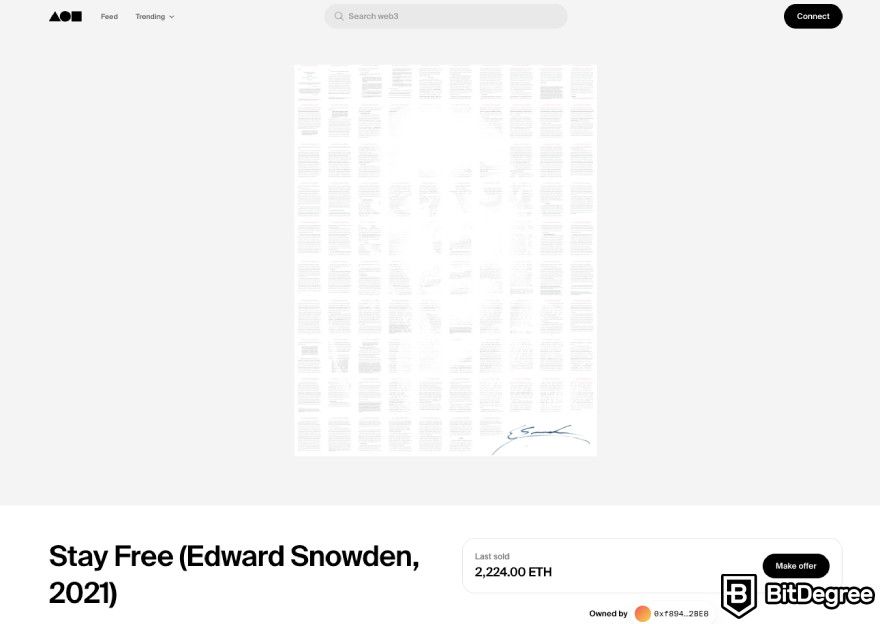
"Stay Free" is a special piece, signed by Snowden, that brings together a pivotal court decision declaring the National Security Agency's mass surveillance as unlawful, along with the iconic portrait of the whistleblower. Notably, this is the sole NFT created by Snowden, and was auctioned on behalf of Freedom of the Press Foundation for 2,224 ETH (around $5,5 million at the time!).
So, Foundation stands at the intersection of crypto and culture, forging connections between artists and collectors. Foundation NFT reviews are highly positive, as the platform goes beyond being a marketplace: it's a community-driven path that pioneers cultural curation and shares tools with the ever-evolving community of developers shaping the future.
Seamless Design for Effortless Use
This Foundation review wouldn't be complete without tackling one of the main issues regarding NFT platforms: user-friendliness.
Navigating the Foundation NFT platform is a breeze, making the entire experience seamless for both seasoned digital art enthusiasts and newcomers alike. It boasts a clean and polished look that immediately catches the eye.
The platform's design is not just aesthetically pleasing but also highly functional. It's user-friendly, offering an interface that doesn't overwhelm customers with unnecessary options. Whether you're a digital art connoisseur or a first-time visitor, finding your way around Foundation is refreshingly straightforward.
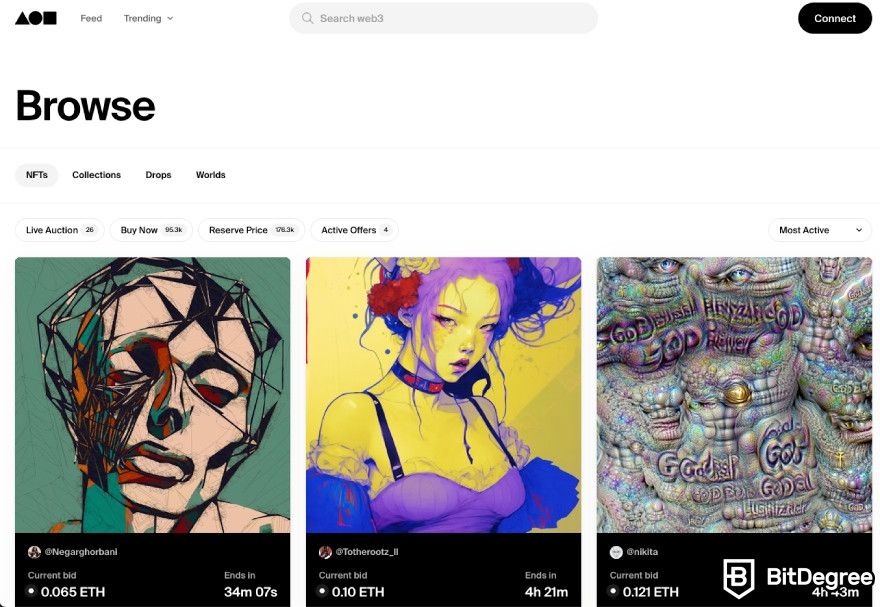
The platform's intuitive design extends to its filtering system. Users can effortlessly narrow down their choices using filters, making the process of discovering and bidding on curated NFT artwork a smooth journey. Keeping track of your bids is a cinch, thanks to the thoughtfully integrated features that enhance the overall user experience.
For those unfamiliar with the intricacies of the NFT art world, Foundation provides a welcoming environment. Trending creators and pieces are easily accessible, and browsing the marketplace is a delight. Even if it's your first time exploring the platform, you'll find it easy to locate collections, check out exciting creators, and acquire NFTs that catch your interest.
Royalties Can Be Divided Among Creators
Now, one of the standout features I want to talk about in my Foundation review is the possibility for creators to seamlessly split earnings among collaborators. This process, known as a "split", goes beyond traditional revenue sharing and adds a layer of versatility to the distribution of funds within the NFT space. For artists, musicians, galleries, record labels, and even causes, it's a game-changer.
So, what exactly is a split? Well, it's a mechanism that allows creators to share earnings with up to three other recipients. Whether you're teaming up with fellow artists or supporting a cause you're passionate about, splits create new avenues for revenue and reward collaborative efforts.
The beauty of splits extends beyond the initial sale. Every participant in a split receives funds from the primary market sale and continues to earn a share of the earnings for all secondary market sales, ensuring a perpetual flow of royalties. A good royalty structure is very important for the success of an NFT marketplace[1].
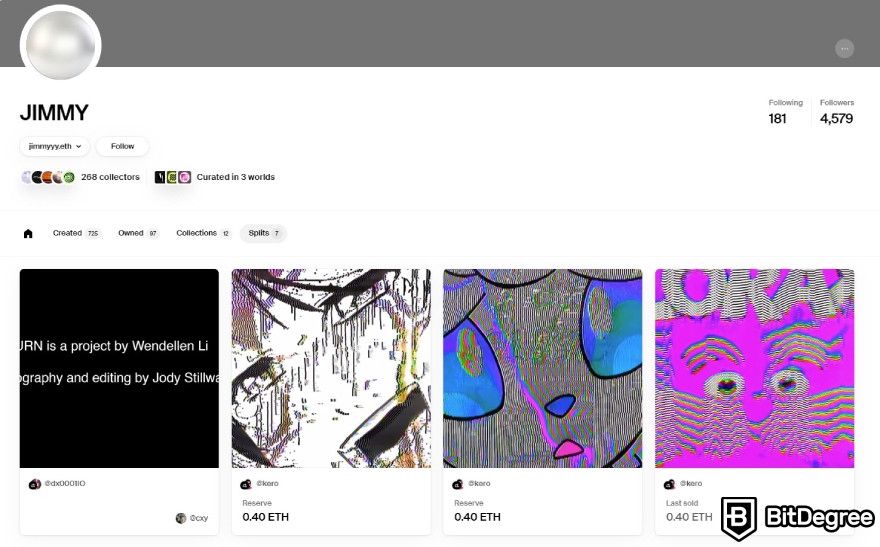
When a work is sold on the secondary market, a 10% royalty is earned from the final sale price. All recipients then receive a percentage of this royalty based on their original split percentage. It's a fair and transparent way to acknowledge and compensate all those involved, and that's why this Foundation price system is so loved by artists.
Once a split is created, visibility is key. The NFT will be showcased on all participants' profiles under the Splits tab. If you're the creator of the split, it will also be displayed on the Created tab on your profile, ensuring due credit and recognition.
In essence, Foundation's split feature not only fosters collaboration but also ensures a fair and ongoing distribution of royalties, making it a noteworthy platform for creators in the NFT space.
Multiple Ways to Sell NFTs
Foundation offers a diverse array of selling options, providing artists and collectors with a dynamic space to showcase and trade their digital creations. Many of them mention that in their Foundation reviews.
Foundation's Reserve Auction feature lets you kickstart a bidding war for your NFT. Set a starting price, determine the auction duration (anywhere from 15 minutes to 7 days), and watch as potential buyers place bids. The countdown timer resets with each bid in the final 15 minutes, ensuring a fair chance for everyone. Once the timer hits zero, the highest bidder takes home the NFT.
For those looking for quick sales, the Buy Now option is a game-changer. Set a fixed price, and interested buyers can snag your NFT instantly with a simple click. The straightforward process makes it a go-to for artists aiming for swift transactions.

Besides, Foundation allows potential buyers to make offers on your NFTs. You hold the power to accept or let an offer expire. It adds a layer of flexibility, letting you tailor your selling approach based on incoming offers.
Now, there are also Drops, which are curated collections with fixed sizes and pricing models. Collectors can mint blind, with the actual NFT revealed later. It's a unique way to create anticipation and engage your audience over time.
Moreover, you can create scarcity with Editions, offering a limited-time window for collectors to mint from an unlimited supply. Whether it's a timed edition lasting up to 7 days or until the max token supply is reached for limited editions, this feature adds exclusivity to your NFTs.

On top of that, you can collaborate with curators in on-chain groups known as Worlds. Set reserve auction or buy now prices with the added benefit of curators sharing in the final sale. It's a community-driven approach to selling NFTs.
Additionally, there is batch listing, which allows creators to list up to 50 NFTs at once. This streamlined process simplifies the listing of collections, saving time and effort for busy artists.
Mix and match these features until you find the sweet spot for your unique style. Whether you prefer the thrill of auctions or the speed of direct sales, Foundation's versatile platform empowers you to tailor your selling strategy to your liking.
Exciting Auctions
A pro side that could never be left out of a Foundation NFT review is the attention-grabbing power of auctions.
Auctions are like the rockstars of the NFT world, creating a buzz that's hard to ignore. The beauty lies in the FOMO. The excitement builds as the clock ticks down, encouraging potential buyers to jump in and place their bids.

Picture this: you glance at an incredible NFT on its journey through the auction phases as bids roll in. You place a bid, as you hope to add it to your fine collection. The countdown timer ticks away, and here's the kicker – every bid within the last 15 minutes resets the clock.
It's a thrilling game of bids and resets until the timer hits zero. Then, you (the highest bidder!) walk away victorious, holding your prized NFT.
In a nutshell, Foundation's auctions aren't just about selling – they're about creating an event, a spectacle that captivates the audience and keeps them on the edge of their seats until the final bid.

Did you know?
All Crypto Exchanges may look similar to you but they're NOT all the same!
Foundation Review: CONS
Now that I've covered all the major pros offered by this NFT marketplace, I must also look into some drawbacks. Otherwise, it wouldn't be a complete Foundation review.
Only Accepts ETH
As I've already mentioned in the beginning of this review, the Foundation NFT marketplace exclusively accepts ETH for purchases. This means if you've got your eyes on a dazzling piece of digital art and you're holding Bitcoin or any other cryptocurrency, well, you're out of luck.
When it comes to Foundation, ETH is the sole player in the purchasing game. No fiat currency, no Bitcoin, just ETH. While Ethereum is widely available on most major crypto platforms, it might pose a bit of an inconvenience for those who prefer the flexibility of using various cryptocurrencies or even their credit cards.
One platform you might be interested in is Ogvio. It lets you trade into ETH inside the app after you've topped up (fiat bank top-ups have 0 Ogvio fees). From there, crypto transfers are nearly instant, so you can move funds to an external wallet quickly when you need it. In addition, sending cryptocurrency on Ogvio doesn't incur any fees.

Now, I get it, Ethereum is not exactly a rare unicorn in the crypto space, and acquiring it isn't rocket science. All popular crypto exchanges like Binance or Kraken have it up for grabs. So the good news is, if you're already in the crypto game, getting your hands on some ETH isn't a monumental task.
However, the landscape of NFT marketplaces is diverse, and some platforms out there play nice with different cryptocurrencies and even traditional card payments. So, if you're a Bitcoin enthusiast or have a penchant for paying with your credit card, Foundation's exclusive ETH policy might feel a tad restrictive.
High Fees
Another potential nuisance you might notice discussed in Foundation NFT reviews is relatively high fees. It hits you with a 5% fee for both primary and secondary market sales. But wait, there's more – for Drops, that hot new feature everyone's buzzing about, it's a steeper 15% on the primary market.
You might wonder, where does all that money go? Well, Foundation says it's for the greater good – development and maintenance of the marketplace. Great, but, if you pair it with the unavoidable gas fees, the fuel that powers the Ethereum network, you have to give away a pretty big chunk out of your earnings.
That said, let’s get into more detail about Foundation prices for selling and buying art.
Foundation Price Structure
So, there are two types of fees on Foundation to consider: marketplace fees and gas fees. Any Foundation review needs to tackle both, as they can be seen as drawbacks, even in an exclusive marketplace such as this.
First up, we've got marketplace fees.
Foundation keeps it straightforward. As you already know, for all sales, whether it's on the primary or secondary market, there's a 5% cut. Fairly simple. But when it comes to Drops, things shift a bit. On the primary market, it's a 15% fee, while secondary sales stick to the familiar 5%. So, that 5% is the magic number on the Foundation NFT marketplace.
Now, you might be wondering where these fees end up. As I've mentioned before, they're not just disappearing into the digital abyss. Foundation puts them to work, channeling those funds into developing and maintaining the marketplace. Without fees, Foundation NFT wouldn't be able to develop creator tools like Editions, Worlds, or Drops.

The Foundation price lies in these Web3 solutions, and the fees you pay are the fuel that keeps this creative engine running smoothly.
Next in line, we've got gas fees.
Gas, in the crypto world, isn't something you put in your car – it's the mandatory fee for any transaction or smart contract on the Ethereum network[2]. Think of it as the juice that keeps the Ethereum gears turning, and it goes directly to the miners who work hard to keep the network ticking.
Of course, note that those gas fees don't find their way back to Foundation. So, when you're making moves on Foundation, remember that the gas fees are the Ethereum network's way of keeping the lights on, not adding to Foundation's piggy bank.
How to Use Foundation?
The last thing I want to do in this Foundation review is break down the ABCs of navigating this impressive marketplace.
How to Log Into Foundation?
So, first things first: how do you log into Foundation?
Step 1: Click [Connect] in the upper right corner.
![Foundation review: the [Connect] button. Foundation review: the [Connect] button.](https://assets.bitdegree.org/images/foundation-review-connect.jpg)
Step 2: Choose your Ethereum wallet – MetaMask, Coinbase Wallet, WalletConnect (which lets you connect other wallets, like Ledger), or any other supported option. I went with MetaMask, but you should choose the Ethereum wallet of your preference. Besides, if you don't have a wallet, you can select [I don't have a wallet] at the bottom to set one up.
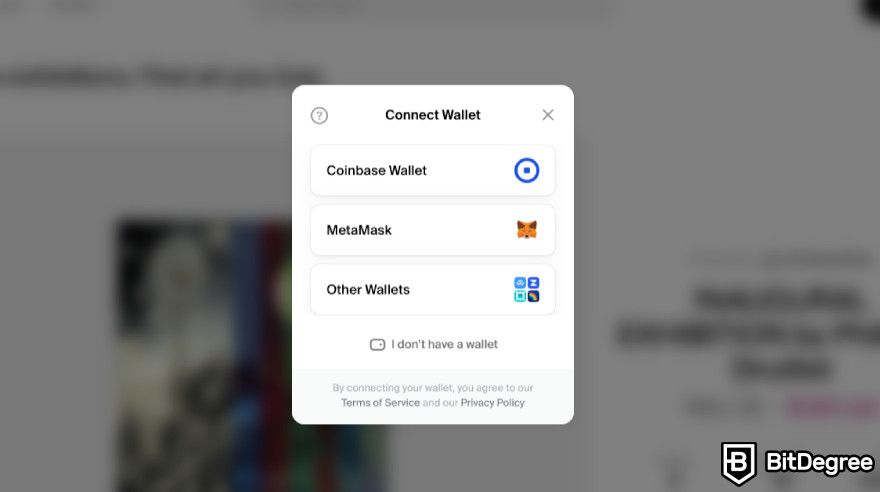
Step 3: Confirm the connection in the wallet extension window that will pop up. Click [Next] and then [Sign].
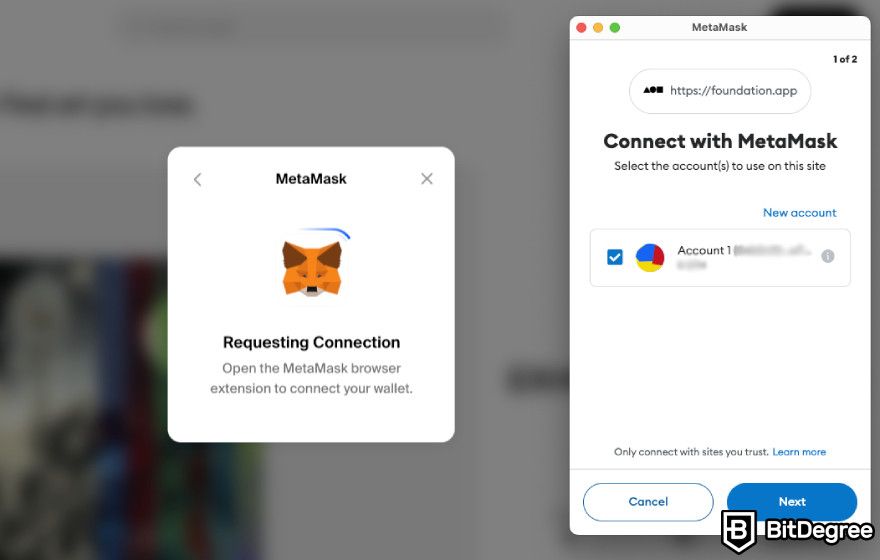
Once you do that, you'll also be asked for another signature to verify you're the owner of the wallet.
How to Buy NFTs on Foundation?
Now, let's get to what everybody wants to know: how to buy Foundation's incredible NFTs.
Step 1: With your wallet connected, find an NFT you're interested in. If you're still not sure of which NFT to get, check out Collections, Drops, Editions, Buy Now, Active Offers, Reserve Auctions, and Worlds to find what suits your taste.

Step 2: Make your purchase. There are a few different ways to do that, depending on the type of collection you chose:
For Drops or Editions, click [Mint] and confirm the transaction in your wallet.
![Foundation review: the [Mint] button. Foundation review: the [Mint] button.](https://assets.bitdegree.org/images/foundation-review-mint.jpg)
For Buy Now, click [Buy], confirm the transaction, and pay the gas fee. Alternatively, you can click on [Place bid] if you want to offer your own price, but the purchase will not be instant then.
![Foundation review: the [Buy] button. Foundation review: the [Buy] button.](https://assets.bitdegree.org/images/foundation-review-buy.jpg)
For Offers or Reserve Auctions, place a bid or make an offer.
![Foundation review: the [Place bid] button. Foundation review: the [Place bid] button.](https://assets.bitdegree.org/images/foundation-review-place-bid.jpg)
There you go! You're now the proud owner of an NFT on Foundation. Happy collecting!
How to Create and Sell NFTs on Foundation?
If you're a creator looking for a place to showcase your artwork, this Foundation review has got you covered, too. So, here's what you'll do:
Step 1: While logged in, head to the creation menu by clicking [Create], which'll be on the same spot where the [Connect] button was: upper right corner.
![Foundation review: the [Create] button. Foundation review: the [Create] button.](https://assets.bitdegree.org/images/foundation-review-create.jpg)
Step 2: Explore your options. As said before, there are many ways to sell (and, therefore, to create) in Foundation, so you should choose the one that best fits your artwork, interests, and strategy. To exemplify the creation process, I'm going to create a [Drop].
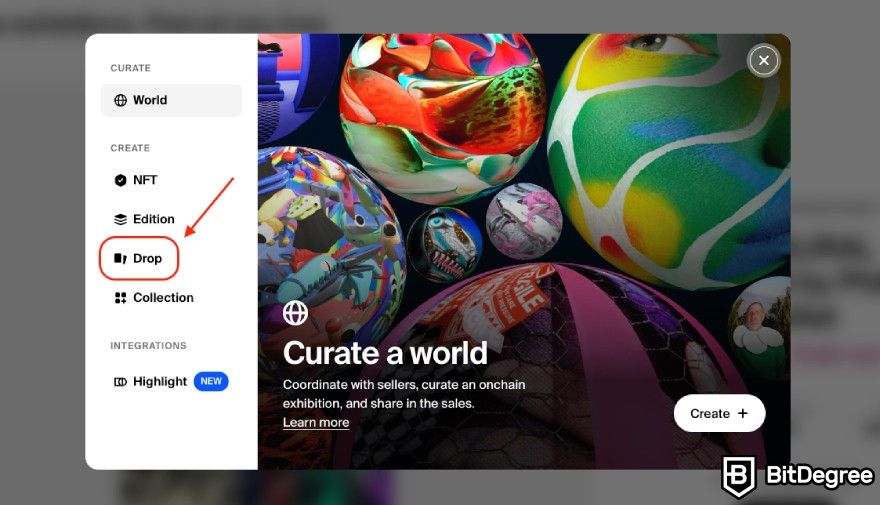
Step 3: If you're also creating a Drop, it's time to decide your smart contract's name, symbol, and the number of NFTs that'll be available on your Drop.

Step 4: Upload your pre-reveal asset, which will be like a cover to the actual asset each buyer will get. It can be a GIF circling through the artworks that'll be available in the Drop, for example.
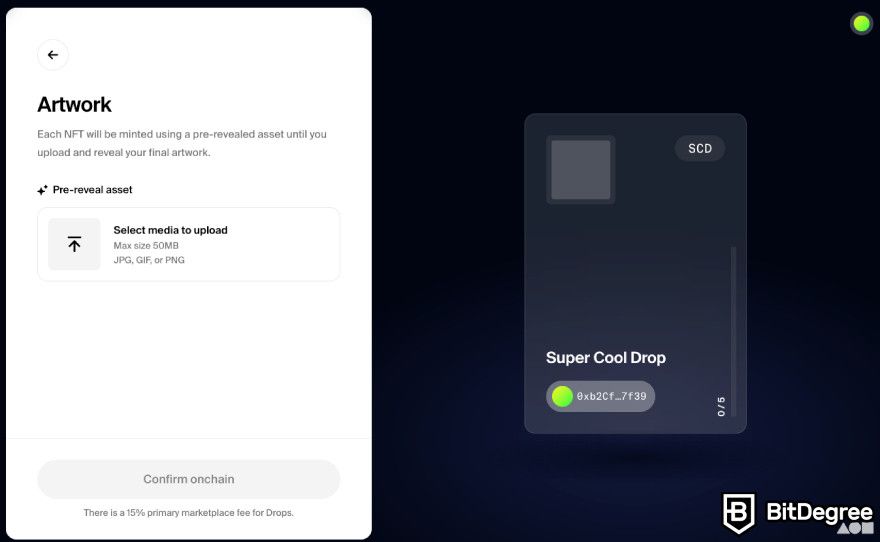
Step 5: Hit [Confirm onchain] and pay the gas fee on your wallet extension window that will pop up. Once you do that, you'll have successfully deployed your first NFT Drop on Foundation.
Conclusions
In wrapping up this Foundation review, it's evident to mention that this NFT platform boasts an air of exclusivity that sets it apart. The user-friendly interface makes navigating the world of curated NFT artwork a breeze, and the option to divvy up royalties among creators adds a nice touch of fairness.
The allure of multiple selling methods, coupled with attention-grabbing auctions, provides artists with a dynamic platform to showcase their creations. It's a digital marketplace that not only sells art but also orchestrates a spectacle around it.
However, like any platform, the Foundation NFT marketplace has its quirks, too. The fees for creators can be on the higher side, which could be a consideration for artists mindful of their bottom line. Plus, the exclusive embrace of Ethereum might leave some users wishing for more payment options. If you're looking for more versatility in this regard, OpenSea allows you to buy NFTs with fiat.
With more payment options on the mind, funding a crypto balance by card can be the simpler route; Ogvio lets you buy crypto via card payments, bank transfers, and other methods. The best part is that it doesn't charge you anything for crypto transfers, so after you've funded the balance, you can send it to your external wallet without worrying about extra costs!
The content published on this website is not aimed to give any kind of financial, investment, trading, or any other form of advice. BitDegree.org does not endorse or suggest you to buy, sell or hold any kind of cryptocurrency. Before making financial investment decisions, do consult your financial advisor.
Scientific References
1. W. Yang, Z. Shi, S. Lin: 'Art, Smart Contracts, and the Role of Royalties';
2. D. Koutmos: 'Network Activity and Ethereum Gas Prices'.


